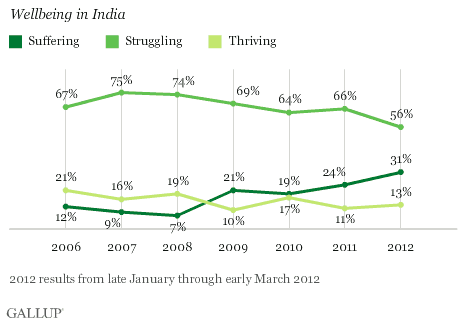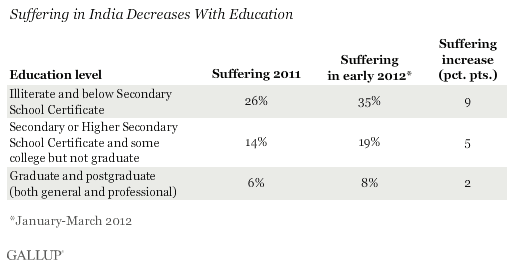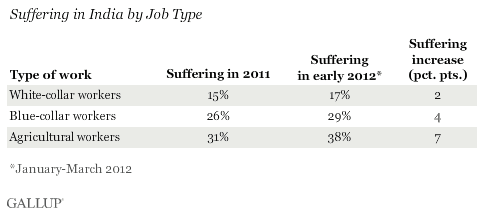WASHINGTON, D.C. -- More than three in 10 Indians rate their lives poorly enough to be considered "suffering" in the first quarter of 2012, up from 24% last year.

Gallup classifies respondents as "thriving," "struggling," or "suffering," according to how they rate their current and future lives on a ladder scale with steps numbered from 0 to 10 based on the Cantril Self-Anchoring Striving Scale. Those who rate their present life a 7 or higher and their life in five years an 8 or higher are classified as thriving, while those who rate both dimensions a 4 or lower are considered suffering. Respondents whose ratings fall in between are considered struggling.
Least Educated Indians Suffering Most
Some of the increase in suffering between 2011 and early 2012 may be attributable to the timing of the 2012 survey, which was conducted before harvest time in parts of India, when many farmers likely had gone without pay for several months. However, that so many Indians rate their lives so poorly may seem inconsistent with the country's high levels of economic growth and its rising-star status in the global economy.
Suffering levels among the most educated and the least educated Indians suggest the gaps between the haves and have-nots may actually be widening. More than one-third (35%) of Indians who have not completed secondary school are considered suffering in early 2012, versus 8% of those who have completed graduate education or more. While suffering increased in each educational group between 2011 and early 2012, it increased most among Indians with the lowest education. Especially noteworthy, suffering jumped to 47% in early 2012 from 35% in 2011 for the illiterate group.

Educational opportunities are by no means universal in India; especially hard-hit are children living in rural areas. Although 95% of Indian children now live within one kilometer of a public school -- and enrollment has increased annually -- school attendance is decreasing in rural India. The 2011 Annual Status of Education Report finds a decline in attendance at rural primary schools to 70.9% in 2011 from 73.4% in 2007. The report also shows an overall decline in national reading and mathematics proficiency to the point where most Indian children are now considered to be two to three years behind expectations.
A 2011 Organization for Economic Cooperation and Development (OECD) report revealed India's serious dearth of higher learning. According to OECD, during the 2007-2008 school year, 13.6% of Indian college-aged students were enrolled in higher education -- a figure much lower than international standards.
Suffering Grows Among Agricultural Workers
Although more than half of India's economic output comes from highly skilled technology services, that sector employs one-third of the labor force. More than half of the workforce is engaged in agriculture, part of a low-skilled, lower-paid labor pool. While suffering increased somewhat among Indian white-collar and blue-collar workers between 2011 and early 2012, it increased most for agricultural workers -- which could partly reflect the timing of the survey. Now, roughly twice as many agricultural workers (38%) as white-collar workers (17%) rate their lives poorly enough to be considered suffering.

Implications
India has made significant progress since its economic liberalization in 1991, yet to achieve its overall economic goals, continued efforts will be needed in education reform -- particularly with attendance issues in rural areas, and an increase in the required number of years of educational attainment. Given that those with more education and those who work in more highly skilled jobs are the least likely to be suffering, improving educational standards would likely help India reduce its high levels of suffering. Moreover, a large pool of educated, skilled workers will be needed to sustain and support the nation's rapid economic growth.
For complete data sets or custom research from the more than 150 countries Gallup continually surveys, please contact SocialandEconomicAnalysis@gallup.com or call 202.715.3030.
Survey Methods
Results are based on face-to-face interviews with approximately 5,000 adults, aged 15 and older, conducted between Jan. 29-March 8, 2012, in India. For results based on the total sample of national adults, one can say with 95% confidence that the maximum margin of sampling error is ±1.7 percentage points. The margin of error reflects the influence of data weighting. In addition to sampling error, question wording and practical difficulties in conducting surveys can introduce error or bias into the findings of public opinion polls.
For more complete methodology and specific survey dates, please review Gallup's Country Data Set details.
